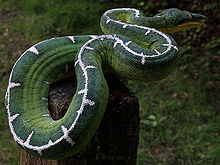Corallus batesii, also known commonly as the Amazon Basin emerald tree boa, is a species of snake in the subfamily Boinae of the family Boidae. The species is native to the tropical rainforests of South America. This species was revalidated from the synonymy of Corallus caninus by Henderson and colleagues in 2009.[3][4]
| Corallus batesii | |
|---|---|

| |
| Scientific classification | |
| Domain: | Eukaryota |
| Kingdom: | Animalia |
| Phylum: | Chordata |
| Class: | Reptilia |
| Order: | Squamata |
| Suborder: | Serpentes |
| Family: | Boidae |
| Genus: | Corallus |
| Species: | C. batesii
|
| Binomial name | |
| Corallus batesii (Gray, 1860)
| |
| Synonyms | |
| |
Taxonomy and etymology
editEnglish naturalist John Edward Gray originally described this species as Chrysenis batesii in 1860.[5] The specific name, batesii, is in honor of Henry Walter Bates, an English naturalist and explorer, for whom Batesian mimicry is also named.[6]
Description
editThe Amazon Basin emerald tree boa has a yellow belly. The dorsum is dark green with an enamel-white vertebral stripe, which has confluent partial crossbars, often bordered by some black spots. C. batesii differs from C. caninus by the shape and the number of scales across the snout. C. batesii is bigger than C. caninus, growing to a total length (including tail) approaching 9 feet (2.7 m).[7]
Behavior
editCorallus batesii is arboreal, and it is both diurnal and nocturnal.[1]
Diet
editCorallus batesii is capable of hunting small airborne prey, such as bats and birds, as well as rodents, opossums, lizards (including Thecadactylus solimoensis), and other snakes (including Bothrops atrox).[1][8]
Reproduction
editCorallus batesii is ovoviviparous.[1]
Geographic range and habitat
editCorallus batesii, the "Amazon Basin species", as the common name suggests, is only found in the basin of the Amazon River, in southern Suriname, southern Venezuela to Colombia, Ecuador, Peru and Brazil and in the surrounding jungles of the Amazon River.[9] It is found at elevations from sea level to 1,000 m (3,300 ft).[1]
References
edit- ^ a b c d e Rivas G, Gutiérrez-Cárdenas P, Caicedo J, Hoogmoed M, Gagliardi G, Cisneros-Heredia DF, Nogueira C, Gonzales L (2016). "Corallus batesi [sic]". The IUCN Red List of Threatened Species 2016: https://dx.doi.org/10.2305/IUCN.UK.2016-3.RLTS.T203207A2762173.en. Downloaded on 11 June 2021.
- ^ McDiarmid RW, Campbell JA, Touré T (1999). Snake Species of the World: A Taxonomic and Geographic Reference, Volume 1. Washington, District of Columbia: Herpetologists' League. 511 pp. ISBN 1-893777-00-6 (series). ISBN 1-893777-01-4 (volume).
- ^ a b Corallus batesii at the Reptarium.cz Reptile Database. Accessed 30 July 2016.
- ^ "Corallus batesii ". Integrated Taxonomic Information System. Retrieved 12 July 2016.
- ^ Gray JE (1860). "Description of a New Genus of Boidæ discovered by Mr. Bates on the Upper Amazon". Annals and Magazine of Natural History, Third Series 6: 131-132. (Chrysenis batesii, new species). (original text).
- ^ Beolens, Bo; Watkins, Michael; Grayson, Michael (2011). The Eponym Dictionary of Reptiles. Baltimore: Johns Hopkins University Press. xiii + 296 pp. ISBN 978-1-4214-0135-5. (Corallus batesii, p. 19).
- ^ Henderson, Robert W.; Pauers, Michael J.; Colston, Timothy J. (2013). "On the congruence of morphology, trophic ecology, and phylogeny in Neotropical treeboas (Squamata: Boidae: Corallus)". Biological Journal of the Linnean Society. 109 (2): 466–475. doi:10.1111/bij.12052.
- ^ https://www.reptilesofecuador.com/corallus_batesii.html
- ^ Bernarde PS, Albuquerque S, Barros TO, Turci LCB (2012). "Serpentes do Estado de Rondônia, Brasil ". Biota neotrop. 12 (3): 1-29. (in Portuguese, with an abstract in English).
Media related to Corallus batesii at Wikimedia Commons
